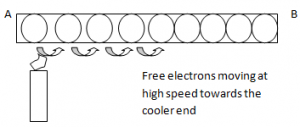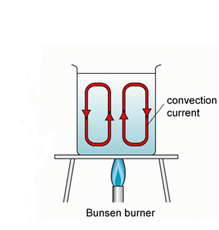Thermal energy always flows from a region of higher concentration to a region of lower temperature.
Conduction:
Conduction is the process of thermal energy transfer without any flow of the material medium
Conduction occurs mostly from solid to solid due to molecular vibration.
- The particles at A absorbs heat energy and vibrate faster
- The particles collide with the neighbouring particles and pass the heat energy to B
Metal is a good conductor of heat and plastic, rubber and glass are poor conductors of heat.
Why Metals Are Better Conductors?
Metals have free moving electrons. The electrons on the hot end gain energy and move faster as a result. These electrons than diffuse into the cooler end and when they collide with atoms on the cooler end they transfer energy.
Convection:
Convection Is the transfer of thermal energy by means of currents in a fluid (liquids or gases)
- Hot water rises, cold water sinks to set up conventional current.
- Hot water at bottom gets heated and rises. Cold water being more dense sinks.
- The movement of the liquid due to a difference sets up a covectional current.
- Hot air being less dense goes up cooler air being more dense goes down
- The cooler surrounding air being denser sinks through the other end of the chimney to replace the less dense air.
Radiation:
Radiation is the continual emission of the infra red waves from the surface of all bodies.transmitted without the aid of a medium. Example, transfer of thermal energy from sun to earth.
Fators Effecting Rate of Infra Red Radiation:
Color and texture of surface:
Dark/ black , dull and rough surfaces are better absorbers and emmitters of infra red radiations than shiny/white and smooth surfaces.
Surface area:
The higher the temperature of the surface of the object relative to the the surrounding temperature, the higher is the rate of infra red radiations.
Surface temperature:
In two objects wth the same mass and material but different surface areas the one with the larger surface area will emmit and absorb infra red radiations at a higher rate.


No comments:
Post a Comment